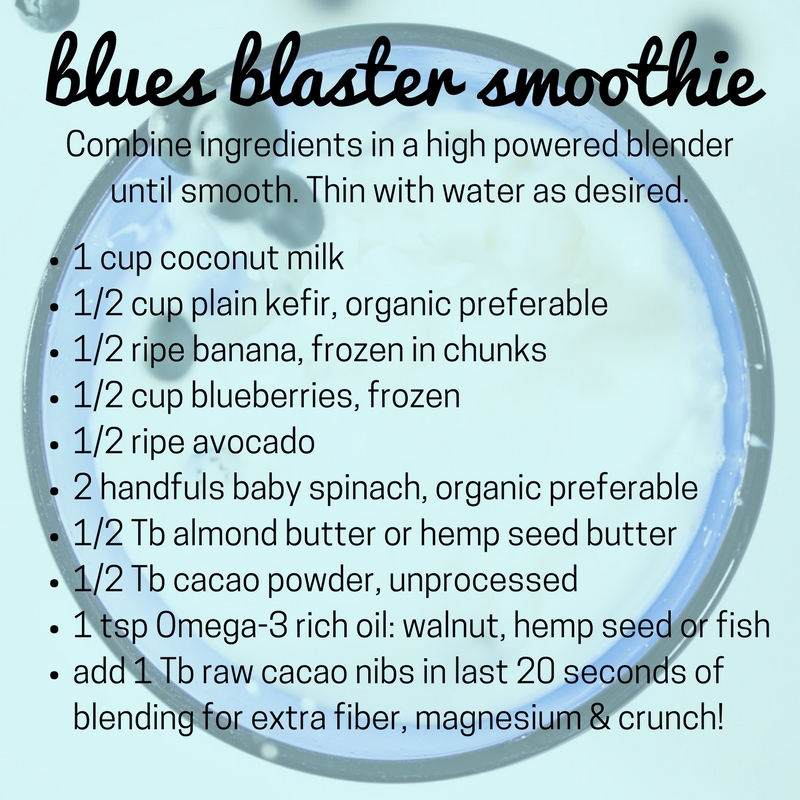FIGHT THE BLUES WITH NUTRITION:
TOP 10 GOOD MOOD FOODS + RECIPE
We can experience depression or even just the blues for many different reasons.
It can be the result of a life circumstance, such as the loss of a loved one, or it can have biological roots, such as in a hormonal imbalance. Some people even experience it seasonally, as in Seasonal Affective Disorder (or SAD).
Whatever its origin, depression can be very debilitating and difficult to manage.
Common symptoms of SAD:
- Feeling sad, grumpy or anxious
- Lose interest in your usual activities, including sex
- Eat more & crave carbs (that’s why we typically crave more bread & pasta in the winter!)
- Weight gain
- Sleep more, but still feel tired
- Have trouble concentrating
How is S.A.D. Diagnosed?
It can sometimes be hard to tell the difference between SAD and other types of depression because many of the symptoms are the same. To diagnose SAD, your doctor will ask if:
- You have been depressed during the same season and have gotten better when the seasons changed for at least 2 years in a row.
- You have symptoms that often occur with SAD, such as being very hungry (especially craving carbohydrates), gaining weight, and sleeping more than usual.
- A close relative a parent, brother, or sister has had SAD and 13-17% of cases are reported to have a genetic predisposition.
- You may need to have blood tests to rule out other conditions that can cause similar symptoms, such as low thyroid or hypothyroidism.
Whether you’ve been diagnosed with SAD, or have symptoms of depression
from other origins, one fact remains the same our moods are intricately linked to the production of certain brain chemicals (neurotransmitters) such as serotonin & dopamine.
How to Beat the Blues with Good Mood Food
Many natural compounds found in foods work as precursors to these critical neurotransmitters, so a shortage of these can dramatically change the way we feel and conduct ourselves. Basically, what we eat plays a significant role in our mood! So, head off to the kitchen for your pick-me-up Rx, you probably have many of these natural foods right in your pantry.
Tryptophan-rich foods
Chicken, turkey, oats, free range eggs, wild-caught tuna, sprouted brown rice, sesame seeds, pumpkin seeds, banana, figs, walnuts and avocado.
What do they do?
Tryptophan is an amino acid which helps the body produce our happy brain chemicals: serotonin, dopamine and melatonin which also aids in sleep.
Vitamin-B rich foods
Sprouted brown rice, whole oats, free range eggs, whole-milk grass-fed dairy like kefir, whole grains, free range chicken & turkey, mushrooms, pumpkin, cabbage, broccoli, asparagus, spinach, tomatoes, cauliflower, red kidney beans, lamb and nutritional yeast, which is especially high in B12 a nutrient often lacking in a vegetarian/vegan diet.
What do they do?
B vitamins aid in the proper functioning of the brain and nervous system. They can help with poor concentration & memory, stress, irritability, anxiety and depression. These important vitamins can easily be depleted when we’re faced with a stressful situation (like every minute of every day for some of us!), so be sure to regularly replenish your levels of B-vitamins.
Magnesium-rich foods
Nuts & seeds – especially almonds, cashews, brazils, pecans & pumpkin, whole grains, beans, garlic, apricots, dried figs, bananas, raisins, dark green leafy vegetables, peas, crab, lentils, soybeans, meats, poultry, fish, raw cocoa or dark chocolate – only 70% cocoa mass or higher!
What do they do?
Magnesium aids the body in dealing with anxiety, depression, irritability, stress, insomnia. It’s nature’s natural relaxant! Just think of how you feel after you’ve soaked in a hot bath filled with Epsom salts (magnesium sulfate).
Zinc-rich foods
Oysters, ginger root, lean red meat (especially lamb), split & green peas, chickpeas, haddock, Brazil nuts, pecans, almonds, egg yolks, whole grains, rye, oats, lentils, pumpkin seeds, green leafy vegetables, mushrooms, Blackstrap molasses, raw cacao or dark chocolate.
What do they do?
Zinc activates areas of the brain that receive and process information from taste and smell sensors and is essential for aiding depression, confusion, loss of appetite, and lack of motivation.
Omega3-rich foods
Wild-caught tuna & salmon, seeds (especially flax, sunflower & pumpkin), and green leafy vegetables – especially spinach & cabbage.
What do they do?
This highly researched essential fatty acid has been reported to influence mood, personality, depression, poor memory and behavior, not to mention the cardiovascular benefits and those for skin, hair & nails!
Selenium-rich foods
Tuna, oysters, cod, poultry, broccoli, cabbage, onions, garlic, whole grains, nutritional yeast, seeds and of course, Brazil nuts are a very high source and you can get your full recommended daily intake in just 1-2 nuts daily!
What do they do?
A deficiency is linked to mood disorders, depression, irritability and hypothyroidism.
TOP 10 GOOD MOOD FOODS
- Cacao & raw chocolate
- Berries
- Bananas
- Salmon & high quality fish oil
- Good fat
- plant foods like avocados & virgin coconut oil
- Poultry
- free range chicken & turkey
- Dark leafy greens
- Eggs
- Nuts & seeds, especially walnuts & hemp seeds
- Probiotic-rich, fermented foods like sauerkraut, kimchi & kefir
How do you make these mood foods work for you right now?
Combine them for even more synergy!
Here are several in a delicious mood-lifting, blues-blasting,
whole food recipe:

comments